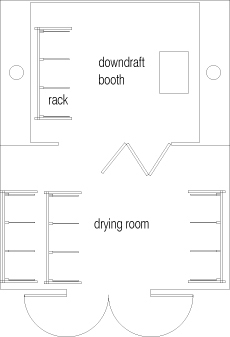Can Spray Finishing Co-Exist with Hand Brushing?
Yes, in an on-site refinishing situation, some pros have success removing the doors for spraying in the shop, and brushing the carcases on site. Here are some details. April 21, 2008
Question
In the wake of waning business, I have had some finishing opportunities. I am set up to spray finish with some pretty good equipment (Binks HVLP) but I don't want the mess of having to mask and tape off an entire room and adjacent rooms (already done this and don't want to do it again). Is it absolutely crazy to think about hand brushing the carcasses and taking the doors/drawer fronts to my shop to spray? Is this going to look bad? Should I finish one way or the other but not mix it?
Forum Responses
(Finishing Forum)
From contributor C:
For it to match really well, yes, it should all be sprayed. Having said that, you can also just buy phenolic backed with unfinished veneer and spray finish in shop and then cut and apply over the existing surface after sanding well. See articles on this in the Knowledge Base here because if you've never done before, there is much to consider.
From contributor M:
I have a customer who brings me doors for 3-6 kitchens a month. I stain and spray his doors. He brushes his edges and finish ends himself. Not something I would recommend, but I have been doing this for him for at least 12 years now.
From contributor D:
Depends on what you are finishing and what finish you are using. I have done it with complete success. If you are painting kitchen or bath cabinets, Muralo Ultra will lay out with a brush on the cabinets and look like it was sprayed just like the doors and drawers were. You have to master the techniques, but it didn't take long.
As for clear coats, General Finish has wipe-on polys and acrylics which I am not that fond of personally, but they work and other finishers I know use them all the time for on-site and in-shop work. Same situation of learning the technique, but it is not difficult, just different.
I would assume there are others, also, which I haven't tried that would work.
From contributor L:
What you describe is my SOP. I have done it many, many times. It's important to get a nice finish on the carcasses, so use a fine bristled brush to minimize brush marks and sand to a nice smooth base before your final coat. I often use a small flocked weenie roller to apply the paint and tip off/cut in with the brush. If you become really skillful with the brush, it will be challenging to get as smooth a finish from the sprayer.
From contributor J:
If you choose to use waterbased finishes, Target's Hybrivar brushes extremely well. Their other products may be brushable with a little retarder. The Hybrivar dries pretty slow and will not need it. I just use a foam brush, though they suggest a Taklon brush. ML Campbell's Agualente pre-cat brushes okay and dries a lot quicker, but it's a TR-2 versus a TR-6 (Hybrivar) and it shows. Edges can be a pain. I would only brush on slab doors. Satin and flat will show fewer brush marks. You will save on materials and mess.
From contributor A:
What's all this talk about R2-D2, C-3PO, TR-2 and TR-6? Durability grading, perhaps?
From contributor J:
Look at the link below. Basically, wood coating companies use these numbers to compare finishes. Keep in mind that the companies list these numbers themselves, rather than have some outside company do it. In general, the higher the number, the more durable the finish.
Objectively Comparing Finish Brands
From contributor A:
I looked on MLC for their TR info and could not find it. What is your source?
From contributor J:
I called the companies and asked. Agualente pre-cat is TR-2 and their post-cat is TR-4. ML Campbell doesn't update their website so often.
